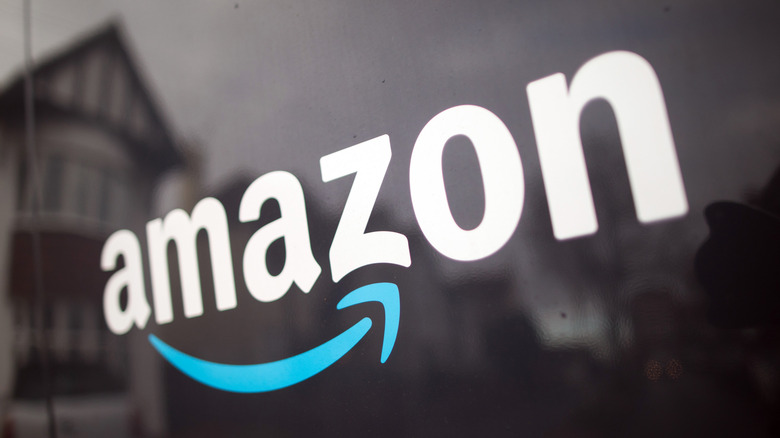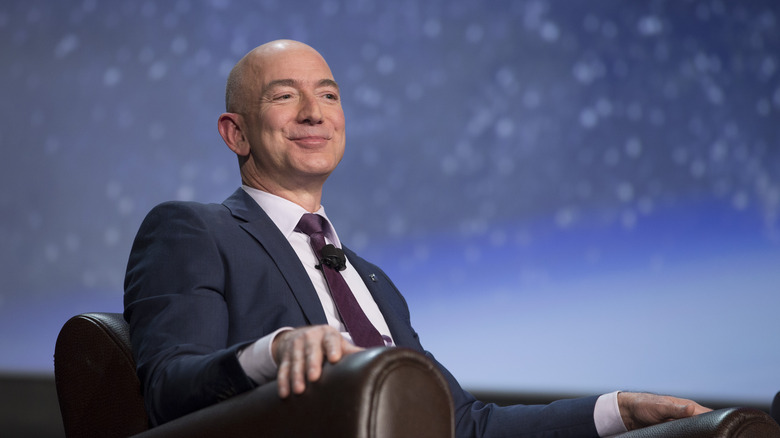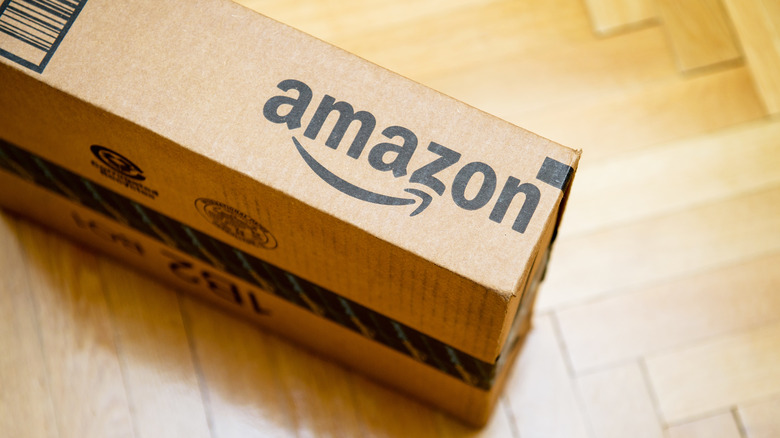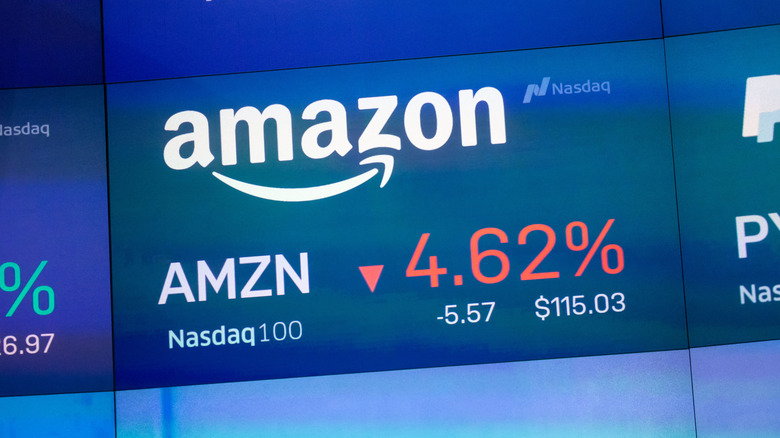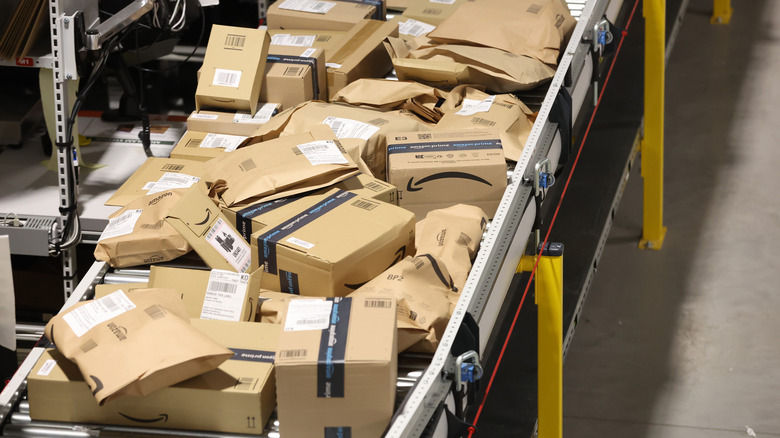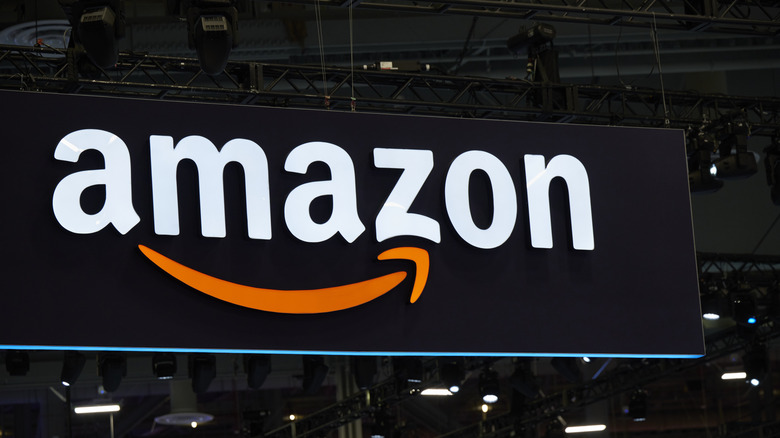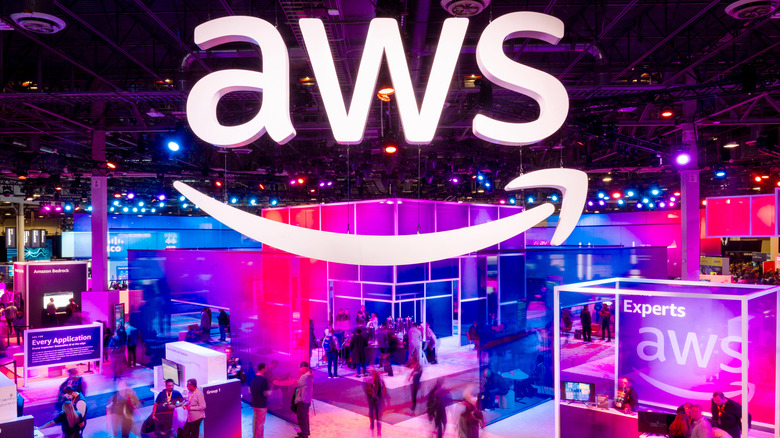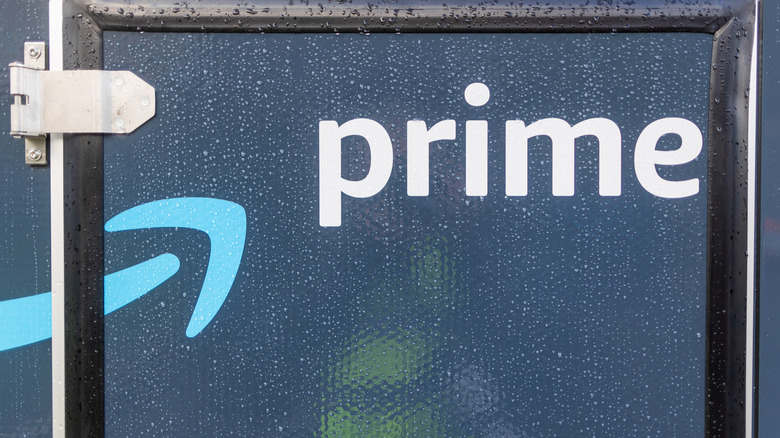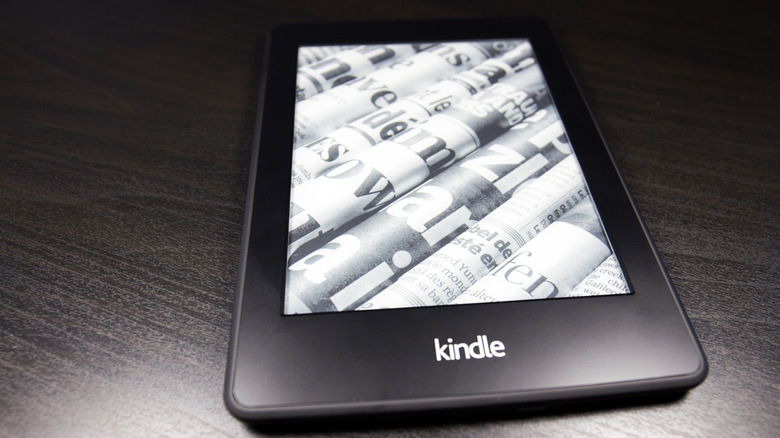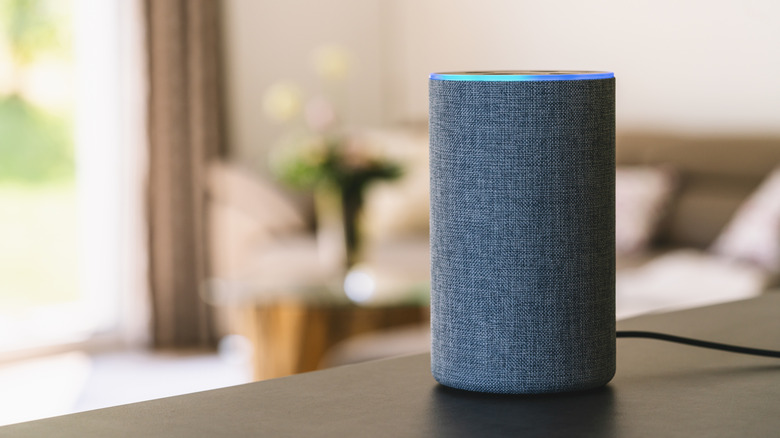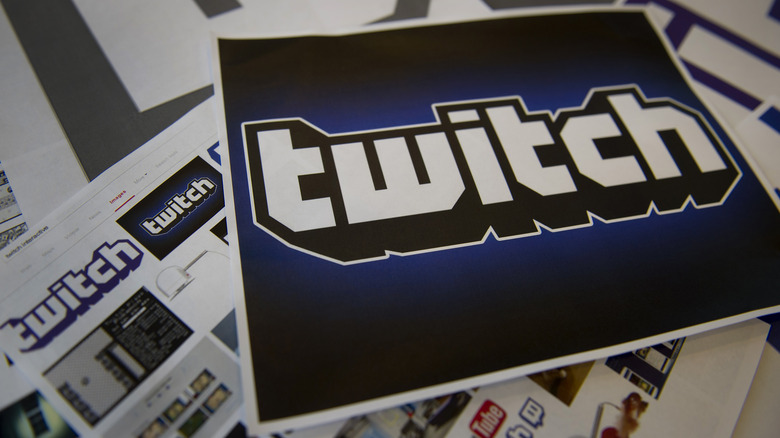10 Of The Biggest Moments In The History Of Amazon
We may receive a commission on purchases made from links.
Amazon has grown from a book retailer operating out of a garage into one of the biggest companies in the world. A mere three decades after it was founded, Amazon now employs well over a million people across the globe and has a value of more than $1.7 trillion. Nowadays, it is not just a retailer but also a tech giant, offering services that range from cloud computing to digital streaming, in addition to artificial intelligence, hardware production, and even self-driving cars. In fact, the only technology companies that are ahead of it in terms of value are the likes of Apple, Microsoft, and Google.
The road to that point wasn't easy, though. Among the many successes, Amazon has had its fair share of failures over the years and there are some important moments in the company's history that you might not be aware of. Still, the history of Amazon is pretty interesting once you dig into exactly how it all started and examine the various stages the company has been through to get where it is today. Here, we are looking at the most important moments in the life of Amazon so far and see how it has come to be such a big part of our everyday experience.
The company is founded in 1994
Jeff Bezos didn't start Amazon because he had a brilliant idea that he felt would be a huge success. Instead, he was fearful of missing out on the internet craze and regretting it later — a decision he referred to as his "regret-minimization framework" in an interview with Time. When he made that choice, Bezos was working in New York at a Wall Street company but quit his lucrative position to move to Seattle, Washington –- a location chosen because it was also home to high-profile technology companies such as Microsoft.
Following his arrival in Seattle in 1994, Bezos began to work on a business plan for his business idea. Having read that e-commerce was set to grow significantly in the years ahead, he settled on opening an online store. While Bezos initially considered a number of products –- including CDs and computer hardware –- he opted for books as they had a worldwide appeal and a huge library of releases to stock.
The Amazon founder was aware that building a strong brand was also important as his concept was not unique and could be easily copied by other companies. When he first set up the company, it was named Cadabra, although this was soon dropped because someone misheard the name over a telephone call and mistakenly thought it was called Cadaver. Amazon was chosen because it suggested something that was both massive and exotic, offering something different on a vast scale. It also had the advantage of beginning with the letter A, which meant it would appear at the start of alphabetical lists of companies.
Amazon sells its first book in 1995
In its early days, Amazon operated out of a rented home in Bellevue, Washington, which is part of the wider Seattle metropolitan area. Specifically, the business was located in the garage of the home and acted as Amazon's headquarters for a while — something that Amazon has in common with other big tech companies like Google and Apple.
Bezos set up the company with the help of his parents, who invested just a little under $250,000 in 1995. This gave Bezos and Amazon some much-needed cash while eventually leading to Jackie and Mike Bezos becoming billionaires due to the shares they received.
Amazon launched on July 16, 1995, although only to select customers who had been invited to beta test the site. John Wainwright, a computer scientist who designed the ScriptX programming language, completed the very first order by purchasing a copy of Douglas Hofstadter's book "Fluid Concepts and Creative Analogies." Within just a few weeks, it had shipped books to all 50 states in the U.S. and to 45 countries around the world. By October, Amazon officially opened its digital doors to the general public, allowing anyone to go online and purchase a book from the retailer.
Amazon goes public in 1997
The next two years moved quickly, and Amazon underwent several changes. Despite keeping its physical headquarters in Seattle, the company reincorporated in Delaware. This is usually done to reduce tax obligations and the state is also home to many other major companies, including Elon Musk's Tesla. However, the most important event during this time was Amazon's initial public offering. This is the process whereby a private company begins to offer its shares to the public for the first time, allowing shares to be traded on a stock exchange.
Amazon's IPO took place on May 15, 1997. The company was launched on the NASDAQ stock exchange under the symbol AMZN with a starting price of $18 per share. This meant that Amazon was now accountable to its shareholders and would have to publish financial information each year to satisfy the requirements of the Securities and Exchange Commission. The meteoric rise in the stock price from this point means that someone who had invested $10,000 at the time of the IPO would have shares that are now worth well over $16 million, with the value of the shares rising by 164,607%.
Amazon launches the Marketplace in 2000
Amazon started as a bookseller before becoming the shopping behemoth it is today. For the first few years of its existence, the retailer exclusively sold books. However, this changed in the late 1990s as the company expanded its offering and began to sell a more diverse range of products. These included everything from CDs and DVDs to electrical goods, helping Amazon to increase its turnover and attract even more customers. Yet, this was just the beginning of what Amazon would eventually become as Jeff Bezos realized that the retailer could find even more success by selling everything.
As reported by CNBC, Bezos told the Economic Club of Washington that he made his decision after he "emailed 1,000 randomly selected customers and asked them, 'Besides the things we sell today, what would you like to see us sell?'" The responses convinced the Amazon founder that customers would buy almost anything they needed online rather than in a traditional store if given the opportunity, paving the path for Amazon to turn into the everything store.
Another major milestone in Amazon's history came when the Marketplace was introduced in 2000. Competing with the likes of eBay, the platform allowed third-party sellers to offer new and used items to customers directly through Amazon's online store. While this allowed some of Amazon's competitors onto the site, it helped ensure that Amazon would become a destination where customers could buy everything they wanted, as sellers could offer products that the online retailer was unable to source itself.
A profit is made for the first time in 2001
Despite finding plenty of success as an online retailer, Amazon wasn't a profitable venture for much of its early history. In fact, the company's leaders did not expect Amazon to make any profit during its first five years of operation.
This might sound unusual, but it is not that strange for tech companies, which invest heavily in expanding and acquiring loyal customers or users before actually making any money. During the late 1990s, Amazon was famously unprofitable, much to the amazement of the public. Jay Leno even interrogated Jeff Bezos about this during an interview, with the Amazon founder laughing off the questions and explaining that the company was focused on expanding rapidly.
This led to worries that Amazon's business strategy was not suitable for the company to survive long-term, with some shareholders complaining about the lack of profits. That all changed in 2001 when Amazon made its first-ever quarterly profit. Although the net profit was small, standing at just $5 million, it marked a significant point in the company's history. By the end of 2003, the company had made a profit across an entire year for the first time, proving that the business model made sense and that Amazon could be a retailer that could consistently make money. This finally allayed shareholder concerns and allowed Amazon to start paying off some of its huge debts.
Amazon Web Services becomes available in 2002
Although most members of the general public might not even be aware of Amazon Web Services, it has become one of the company's most successful and profitable businesses. Yet, despite the fact that many people don't know what Amazon Web Services is, they will have utilized it just by being on the internet as it powers a huge proportion of the websites and services that are part of our everyday lives.
Amazon Web Services is a cloud computing service and collection of APIs that Amazon offers customers. It grew out of the company's own technology that it used to ensure its websites and services could run uninterrupted even when demand suddenly increased. It packed this expertise and technology into a product it could sell to other internet-based businesses and has seen tremendous success, with Amazon Web Services used by everything from Netflix to NASA.
The importance of Amazon Web Services to Amazon as a whole cannot be overstated. In 2020, the division made up 59% of the company's entire profit despite being just over a tenth of the total revenue. Since its launch, Amazon Web Services has almost always made more profit than the rest of Amazon's various divisions combined and is successful enough to be a top-ranking business in its own right.
Amazon Prime arrives in 2005
One of the major advantages of Amazon is that many of the products you buy on the site can be delivered in an incredibly short time. This is typically the next day, although in some cases, Amazon can even get your purchase to you the same day it was ordered. This service first launched in 2005, with Amazon allowing members to pay a yearly subscription fee of $79 to access free two-day shipping across the U.S. and other locations worldwide. This was the start of what would eventually become a major part of Amazon's additional businesses over the coming years.
Amazon Prime later expanded to offer other benefits outside of faster shipping. Significantly, 2011 saw the introduction of Amazon Prime Video, a streaming service that offered thousands of movies and television series to Amazon Prime members at no extra cost. The same year, Amazon added access to the Kindle Owners' Lending Library as part of the subscription. In 2014, the price of Amazon Prime was increased to $99, although it now came bundled with Amazon Music.
The subscription service now offers grocery shopping, free access to certain games, Twitch subscriptions, free ebooks, and an expansive collection of streaming services. Jeff Bezos revealed in 2021 that Amazon Prime had over 200 million active users.
The Amazon Kindle goes on sale in 2007
Amazon has not always had success with its hardware products. Just look at the Fire Phone as proof of that, as the smartphone failed and was discontinued just a year after it first launched. Still, for every failure, Amazon has also had plenty of successes, such as the Kindle. This was Amazon's effort to produce an e-reader that would outperform all others on the market. The results were pretty spectacular, with the first Kindle model selling out almost immediately.
That was in 2011 and the Kindle evolved constantly over the next decade, becoming more refined and simple as it came to resemble paper and real-life books more closely. Considering that Amazon had started life as a book store and had an extensive collection of ebooks, the Kindle made a lot of sense and has remained popular.
Amazon even produced a tablet-like spin-off known as the Kindle Fire — now the Amazon Fire — that combined the ability to read books with other features such as web browsing and playing content such as video or music. Today, the Amazon Kindle is among the very best e-readers and the product line set a new standard for Amazon's hardware releases.
Amazon launches Alexa with its Echo smart speaker in 2014
Outside of the Kindle, Amazon's other major hardware release has been the Amazon Echo. These are a range of smart speakers that utilize Amazon's Alexa virtual assistant technology. The first Echo speaker became available in 2014, although it was initially only able to be purchased by specially invited members. A general release of the Amazon Echo came in 2015, which was soon followed by the smaller and cheaper Amazon Echo Dot. As one of the first smart speakers, the Echo range of devices quickly became popular and has now sold more than 500 million copies as of 2023.
The smart speakers allow users to carry out a wide array of functions. By speaking commands directly to Alexa, it is possible to get everything from news, weather, and traffic updates to details about your own personal events and reminders. The Echo can also be used to control connected smart devices and play content from a range of services like Spotify and Apple Music.
The success of the Echo and Alexa has allowed Amazon to become a constant fixture in millions of homes around the world. Of course, this also allows the company to collect immense amounts of data and get a clearer insight into what consumers want.
Amazon acquires Twitch, Whole Foods, and MGM
Amazon has a history of purchasing other companies and merging with competing businesses to expand its operations. It has used acquisitions as a way of growing from as early as 1998. Early examples include Bookpages in the U.K., ebook software Mobipocket, and IMDb. This is a common tactic by businesses, giving them the ability to swallow up competition, establish their position in a market, and gain control of important technology.
However, Amazon's entry into huge acquisitions started in earnest in 2014 with the $970 million purchase of Twitch. The video streaming site, which was largely dominated by gaming content, had millions of subscribers and was seen as an important way for Amazon to expand outside of retail into other internet-based services. At the time, it was Amazon's largest acquisition and arrived only three years after Twitch had first launched. The purchase came shortly after Google backed out of a potential deal over antitrust issues that might arise as the company also controlled YouTube.
The Twitch acquisition proved to be the catalyst for a number of high-profile purchases that Amazon would make over the next few years. By far the largest of these was the 2017 acquisition of Whole Foods, which Amazon paid $13.7 billion for. However, it also bought doorbell video company Ring and self-driving tech startup Zoox, both for around $1 billion. In 2022, it closed an $8.5 billion deal to take control of movie studio MGM.
